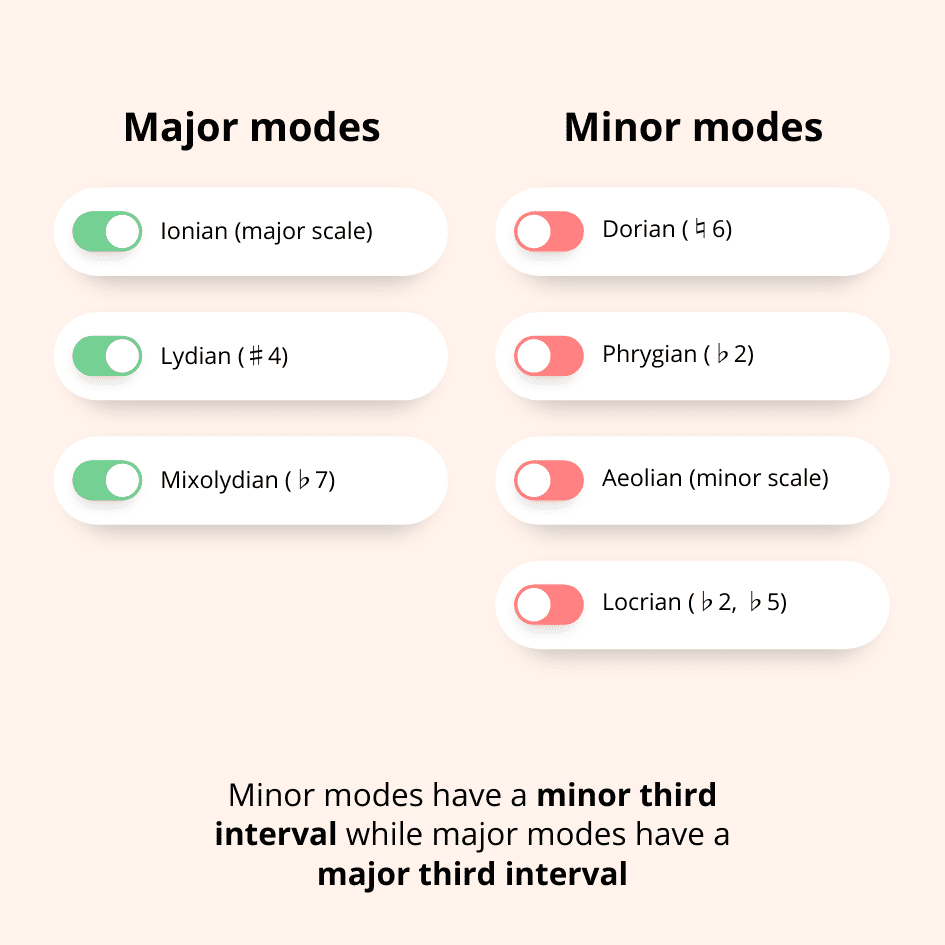
The Dorian mode: useless, abstract theory concept or the key to deeper emotions in your music?
Obviously, I’m going to say it’s the latter. 😁
This post is part of an ongoing series on musical modes, what they are, how they work, and how they can enhance your own music.
In this article, we’re looking at one of the most popular minor modes in all of Western music: the Dorian mode.
We’ll talk about:
- What the Dorian mode is and how to use it
- What the Dorian mode “feels” like in music
- Examples of the Dorian mode across multiple genres and mediums
This is gonna be fun. But first, let’s do quick review on modes as a whole.
Table of Contents
What are musical modes and why are they important?
Musical modes are particular ways to organize musical pitches, not unlike a scale.
Modes are important because they can help us break out of the “major is happy” and “minor is sad” clichés, and allow us to express more nuanced emotions in our music.
In the Western classical tradition, there are seven primary modes, often referred to as diatonic modes:
Many folks will describe modes as just “major scales with different starting notes.” For example, if you take the C major scale…
C – D – E – F – G – A – B – C
…and shift the starting note (tonic) to the second degree, you would construct a scale in the D Dorian mode:
D – E – F – G – A – B – C – D
It’s all the same notes, just shifted over one degree.
This is all well and good, but I don’t think it lends itself well to really learning and internalizing modes (or transposing modes into any other key besides C, because that’s always the one used in these examples).
A better way is to think of modes in two camps: major modes and minor modes.
Major modes are all the modes with a major third, namely:
While minor modes are all the modes with a minor third:
You can think of each mode as a twist or variation of the standard major or minor scale. In our case, we’re focusing on the Dorian mode, which is technically just a minor scale with a major sixth.

That’s it! To me, that’s so much easier to remember and understand than the mental gymnastics of figuring out my starting note for whatever key I’m in.
What is the Dorian mode?
The Dorian mode, as we’ve just described, is a minor scale with a major sixth interval.
So, to put a finer point on it, here is a D minor scale (which we could call an Aeolian mode). It’s just your standard, A-grade, farm-raised, gluten-free minor scale:
D – E – F – G – A – Bb – C – D
Notice the minor sixth interval, the Bb.

Now, this is our D Dorian mode (remember, just a D minor scale with a major sixth):
D – E – F – G – A – B – C – D

Do you hear the difference? It suddenly went from a melodramatic minor scale to a more “triumphant” or “hopeful” minor scale; a minor scale with a bit more spunk, if you will.
What does the Dorian mode “feel” like?
As the title of this post reveals, I like to think of the Dorian mode as “darkness with a hint of light.” It’s got less of a purely sad quality (like the minor scale), and more of a serious, triumphant, or “energized sobriety,” if that makes any sense.
(Hey, it’s music… I’m allowed to use some flowery terminology every now and then.)
The Dorian mode is very often used to evoke a medieval aesthetic, like heroic knights going off to battle. But all-in-all it’s a very versatile mode, and can be used in many different ways.

How Dorian harmony changes the vibe of your music
The Dorian mode, when applied to your harmony, will also change the quality (major or minor) of certain chords. This can lead to really interesting harmonic progressions that fall outside of a typical diatonic range.
To review, if we were to build triads on each of the chords in the D minor scale, we’d have these chords at our disposal:

However, because of our major sixth in the Dorian mode, a few of our chords are altered. Take a look (and listen):

What in tarnation is happening here?
Notice that the Dorian mode has altered three of our triads:
- The E° turns into an Em
- The Gm turns into a G major (probably the most drastic shift)
- And the Bb major turns into a B°
It’s worth noting that you don’t need to stick to just these chords prescriptively. You can oscillate back and forth between a natural minor scale and the Dorian mode (or any other mode) whenever you want. It’s a free country!
This is called mode mixture, and it happens all the time in every type of music.
To really drive this point home, here’s a piano sketch I wrote with chords in the key of D minor:
Dm – Gm – F
Dm – Gm – F – Dm
Now listen to that same idea, but with all the minor sixths played as major sixths (i.e., the Dorian mode).
Dm – G – F
Dm – G – F – Dm
Did you notice the drastic difference in vibe just from that major sixth (especially when the melody accents it)?
How to use the Dorian mode in your music
Now that we know how the Dorian mode is constructed, and what it “sounds” like, let’s talk about how to use it in your music.
First off, you can use it just like any other minor scale:
- For soloing/improvising over a minor chord progression
- For composing a melody in a minor key
- For creating a darker (but not sad) vibe for your music (or evoking that medieval aesthetic)
But because of that major sixth interval, the Dorian mode also works great over major chords! This is especially true for the ii and IV chords in a major key.
Here’s a great example of a Dorian mode in a solo. Listen to it and try to spot where he hits that major sixth for that sweet, sweet Dorian sound.
Examples of the Dorian mode
To get your creative juices flowing, let’s look at some examples of real-life music that uses the Dorian mode.
Scarborough Fair, an English folk song popularized by Simon and Garfunkel, is a textbook example of the Dorian mode.
Its melody hovers around the major sixth in such a gut-wrenching, dramatic way. The song feels somber, without feeling overdramatic (notice that hint of lightness when the lyrics go “parsley, sage, rosemary and thyme”).
Another very prominent example of the Dorian mode in popular music is Mad World, originally written by Tears for Fears, but perhaps most popularized by Gary Jules’ tender piano rendition (which perhaps was even more popularized by the cult classic film Donnie Darko).
Hear the Dorian mode most distinctly in the pre-chorus: “I find it kinda funny, I find it kinda sad.”
And of course, I can’t leave you guys without some solid video game music examples of the Dorian mode (and there are tons).
Remember how I talked about the Dorian mode evoking medieval vibes? There’s probably no better example of that than in the Dark World theme from The Legend of Zelda: A Link to the Past (composed by the legendary Koji Kondo, of course). The melody practically lives on that raised major sixth!
Another awesome example of the Dorian mode in action is probably the strongest tune from the Super Mario RPG soundtrack, Beware the Forest’s Mushrooms by Yoko Shimomura:
Final thoughts
Let’s summarize what we’ve learned:
Modes are an excellent tool for evoking more complex and nuanced emotions in your music.
The Dorian mode is a minor scale with a major sixth. It’s perfect for creating darker sounding music without it feeling sad or overdramatic.
Soloing or writing melodies in the Dorian mode works great over minor chords, but because of that major sixth interval, it also works very well over major chords (especially the ii and IV).
Now that you understand the Dorian mode, try using it in your own music! And if you’re looking for more information on modes, be sure to subscribe to my newsletter (by filling out the form below) so you don’t miss another article.
Thanks for reading!
